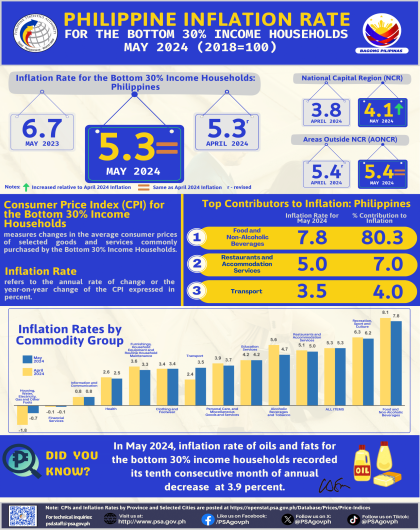FEBRUARY 2020
(Final Results)
Philippines
_2002_F1.gif)
The country’s inflation for the bottom 30% income households eased to 2.2 percent in February 2020. Inflation in January 2020 was recorded at 2.3 percent and in February 2019, 4.3 percent.
The slowdown was primarily due to the slower annual rate of the heavily-weighted food and non-alcoholic beverages index at 0.5 percent. Moreover, the annual gains were slower in the indices of alcoholic beverages and tobacco at 21.9 percent; transport, 2.9 percent; and communication, 0.3 percent.
On the other hand, higher annual mark-ups were observed in the indices of clothing and footwear at 3.0 percent; health, 3.2 percent; and recreation and culture, 3.0 percent. The rest of the commodity groups retained their previous month’s annual growth rates. (Tables 3 and 4)
Inflation for food at the national level, likewise, decelarated to 0.4 percent during the period. In January 2020, it was posted at 0.6 percent and in February 2019, 4.3 percent. (Table 7)
The annual rate of corn index dropped further by 4.6 percent during the month. Likewise, downward movements were still registered in the indices of rice and sugar, jam, honey, chocolate and confectionery as their annual rates went down by 6.3 percent and 2.8 percent, respectively.
Relative to their annual growth rates in the previous month, lower annual increments were noted in the following food groups in February 2020:
- Meat, 2.0 percent;
- Fish, 8.1 percent;
- Vegetables, 5.3 percent; and
- Food products, not elsewhere classified, 7.9 percent.
The rest of the food groups either exhibited higher annual increases during the month or retained its previous month’s annual rate. (Table 5)
| Year-on-Year Inflation Rates of the CPI for the Bottom 30% Income Households for All Items in the Philippines January 2016 – February 2020 (2012=100) | |||||
|---|---|---|---|---|---|
| Month | Year | ||||
| 2016 | 2017 | 2018 | 2019 | 2020 | |
| January | 0.8 | 2.0 | 3.6 | 5.2 | 2.3 |
| February | 0.9 | 2.3 | 4.4 | 4.3 | 2.2 |
| March | 0.8 | 2.3 | 5.0 | 3.5 | |
| April | 0.6 | 2.5 | 5.2 | 3.2 | |
| May | 1.0 | 2.2 | 5.4 | 3.3 | |
| June | 1.2 | 2.1 | 5.5 | 3.2 | |
| July | 1.1 | 2.0 | 6.1 | 2.7 | |
| August | 1.1 | 2.3 | 6.9 | 1.7 | |
| September | 1.2 | 2.6 | 8.0 | 0.3 | |
| October | 1.5 | 2.8 | 8.1 | 0.0 | |
| November | 1.5 | 2.7 | 7.3 | 0.7 | |
| December | 1.8 | 2.8 | 6.4 | 1.9 | |
| Average | 1.1 | 2.4 | 6.0 | 2.4 | |
National Capital Region (NCR)
Similarly, inflation in NCR for this particular group of consumers slid to 1.9 percent in February 2020. Its annual rate was noted at 2.1 percent in the previous month, and 3.7 percent in February 2019.
The indices of housing, water, electricity, gas, and other fuels; and communication correspondingly exhibited annual decreases of 0.9 percent and 0.3 percent. Slowdowns in the annual growths were also observed in the indices of transport and restaurant and miscellaneous goods and services, both at 0.1 percent; and recreation and culture, 0.9 percent.
On the other hand, higher annual increments were noted in the following commodity groups:
- Food and non-alcoholic beverages, 2.7 percent;
- Alcoholic beverages and tobacco, 19.2 percent;
- Clothing and footwear, 1.1 percent;
- Furnishing, household equipment and routine maintenance of the house, 2.2 percent; and
- Health, 2.3 percent.
Meanwhile, the index of education retained its previous month’s annual rate of 5.9 percent. (Tables 3 and 4)
Areas Outside NCR (AONCR)
Following the same trend as that of the national level and NCR, inflation for the bottom 30% income households in AONCR eased to 2.2 percent in February 2020. In the previous month, inflation in AONCR was higher at 2.3 percent, and in the same month in 2019, 4.3 percent.
Slower annual increases during the month were posted in the indices of food and non-alcoholic beverages at 0.4 percent; alcoholic beverages and tobacco, 22.0 percent; and transport, 3.0 percent.
On the contrary, higher annual mark-ups were seen in the indices of clothing and footwear at 3.0 percent; health, 3.2 percent; recreation and culture, 3.1 percent; and restaurant and miscellaneous goods and services, 2.8 percent. The rest of the commodity groups retained their January 2020 annual growth rates. (Tables 3 and 4)
Slower annual increments were recorded in eight regions in areas outside NCR during the month. A zero percent annual rate in Region X (Northern Mindanao) was also noted this month. This was the lowest annual rate recorded among the regions in AONCR during the period. On the other hand, the highest annual rate of 3.5 percent was observed in Region VII (Central Visayas). (Table 4)
Note:
CPIs and inflation rates for the bottom 30% income households by province and selected cities are posted at the PSA website (http://openstat.psa.gov.ph/).
See more at the Consumer Price Index for Bottom 30% Income Households Main page.

